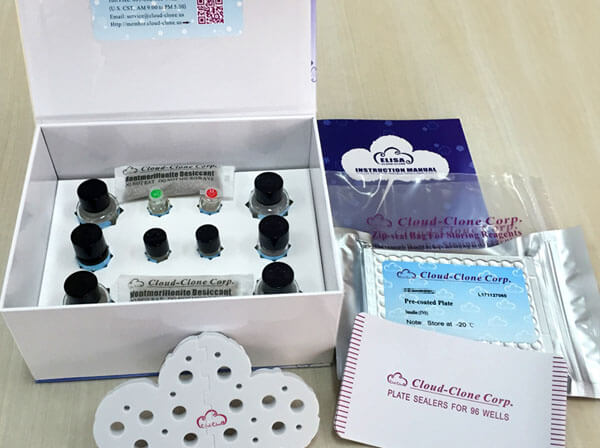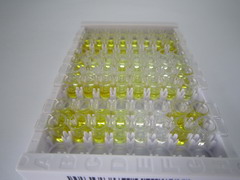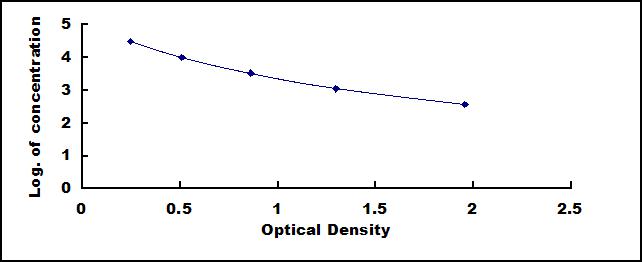ELISA Kit for Fibrinogen Degradation Product (FDP) 

FnDP; Fibrin Split Products; Fibrin Degradation Product
- UOM
- FOB US$ 479.00 US$ 684.00 US$ 3,078.00 US$ 5,814.00 US$ 47,880.00
- Quantity
Overview
Properties
- Product No.CEA530Rb
- Organism SpeciesOryctolagus cuniculus (Rabbit) Same name, Different species.
- ApplicationsEnzyme-linked immunosorbent assay for Antigen Detection.
Research use only - DownloadInstruction Manual
- CategoryMetabolic pathwayHematologyCardiovascular biology
Sign into your account
Share a new citation as an author
Upload your experimental result
Review

Contact us
Please fill in the blank.
Recovery
Matrices listed below were spiked with certain level of recombinant Fibrinogen Degradation Product (FDP) and the recovery rates were calculated by comparing the measured value to the expected amount of Fibrinogen Degradation Product (FDP) in samples.
| Matrix | Recovery range (%) | Average(%) |
| sodium citrate plasma(n=5) | 80-91 | 87 |
Precision
Intra-assay Precision (Precision within an assay): 3 samples with low, middle and high level Fibrinogen Degradation Product (FDP) were tested 20 times on one plate, respectively.
Inter-assay Precision (Precision between assays): 3 samples with low, middle and high level Fibrinogen Degradation Product (FDP) were tested on 3 different plates, 8 replicates in each plate.
CV(%) = SD/meanX100
Intra-Assay: CV<10%
Inter-Assay: CV<12%
Linearity
The linearity of the kit was assayed by testing samples spiked with appropriate concentration of Fibrinogen Degradation Product (FDP) and their serial dilutions. The results were demonstrated by the percentage of calculated concentration to the expected.
| Sample | 1:2 | 1:4 | 1:8 | 1:16 |
| sodium citrate plasma(n=5) | 78-101% | 80-105% | 82-96% | 78-94% |
Stability
The stability of kit is determined by the loss rate of activity. The loss rate of this kit is less than 5% within the expiration date under appropriate storage condition.
To minimize extra influence on the performance, operation procedures and lab conditions, especially room temperature, air humidity, incubator temperature should be strictly controlled. It is also strongly suggested that the whole assay is performed by the same operator from the beginning to the end.
Reagents and materials provided
| Reagents | Quantity | Reagents | Quantity |
| Pre-coated, ready to use 96-well strip plate | 1 | Plate sealer for 96 wells | 4 |
| Standard | 2 | Standard Diluent | 1×20mL |
| Detection Reagent A | 1×120µL | Assay Diluent A | 1×12mL |
| Detection Reagent B | 1×120µL | Assay Diluent B | 1×12mL |
| TMB Substrate | 1×9mL | Stop Solution | 1×6mL |
| Wash Buffer (30 × concentrate) | 1×20mL | Instruction manual | 1 |
Assay procedure summary
1. Prepare all reagents, samples and standards;
2. Add 50µL standard or sample to each well.
And then add 50µL prepared Detection Reagent A immediately.
Shake and mix. Incubate 1 hour at 37°C;
3. Aspirate and wash 3 times;
4. Add 100µL prepared Detection Reagent B. Incubate 30 minutes at 37°C;
5. Aspirate and wash 5 times;
6. Add 90µL Substrate Solution. Incubate 10-20 minutes at 37°C;
7. Add 50µL Stop Solution. Read at 450 nm immediately.

Test principle
This assay employs the competitive inhibition enzyme immunoassay technique. A monoclonal antibody specific to Fibrinogen Degradation Product (FDP) has been pre-coated onto a microplate. A competitive inhibition reaction is launched between biotin labeled Fibrinogen Degradation Product (FDP) and unlabeled Fibrinogen Degradation Product (FDP) (Standards or samples) with the pre-coated antibody specific to Fibrinogen Degradation Product (FDP). After incubation the unbound conjugate is washed off. Next, avidin conjugated to Horseradish Peroxidase (HRP) is added to each microplate well and incubated. The amount of bound HRP conjugate is reverse proportional to the concentration of Fibrinogen Degradation Product (FDP) in the sample. After addition of the substrate solution, the intensity of color developed is reverse proportional to the concentration of Fibrinogen Degradation Product (FDP) in the sample.
Giveaways
Increment services
Citations
- The role of the E2F1 transcription factor in the innate immune response to systemic LPSPhysiology: Source
- Thrombomodulin alleviates murine GVHD in association with an increase in the proportion of regulatory T cells in the spleenPubmed:25243628
- The efficacy of recombinant human soluble thrombomodulin for the treatment of shiga toxin associated hemolytic uremic syndrome model micePubmed:25694534
- Inhibition of Plasmin Protects Against Colitis in Mice by Suppressing Matrix Metalloproteinase 9–Mediated Cytokine Release From Myeloid CellsSciencedirect:S0016508514014851
- Inhibition of Plasmin Protects Against Colitis in Mice byPubMed: 25490065
- Cytoprotective and pro-angiogenic functions of thrombomodulin are preserved in the C loop of the fifth epidermal growth factor-like domainPubmed:29903766
- Temporary inhibition of the plasminogen activator inhibits periosteal chondrogenesis and promotes periosteal osteogenesis during appendicular bone fracture …10.1016:j.bone.2018.04.016
- Nebulized anti-coagulants as a therapy for acute lung injury and acute respiratory distress syndromePubmed: 29202212
- Co-administration of iloprost and eptifibatide in septic shock (CO-ILEPSS)—a randomised, controlled, double-blind investigator-initiated trial investigating …Pubmed: 31488213
- Effects of nebulized antithrombin and heparin on inflammatory and coagulation alterations in an acute lung injury model in ratsPubmed: 31755229











